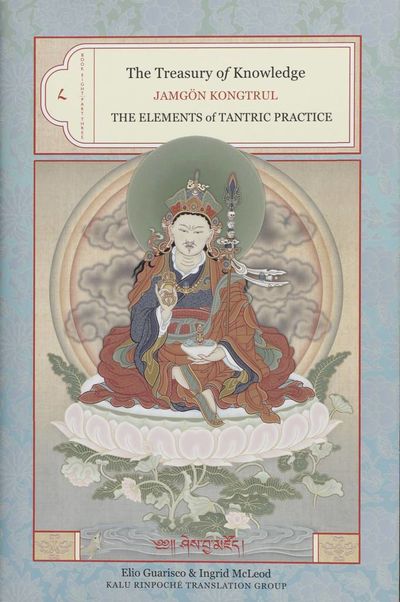(Created page with "{{Book |BookPerson={{Book-person |PersonPage='jam mgon kong sprul |PersonName=Jamgön Kongtrul }}{{Book-person |PersonPage=Guarisco, E. |PersonName=Elio Guarisco }}{{Book-pers...") |
No edit summary |
||
| Line 11: | Line 11: | ||
}} | }} | ||
|FullTextRead=No | |FullTextRead=No | ||
|BookToc=* {{i|Foreword ''by Khenpo Lodrö Dönyö Rinpoché''|vii}} | |||
* {{i|Translators’ Introduction|1}} | |||
* The Root Text: The Elements of Tantric Practice<br> | |||
** {{i|''A General Exposition of the Process of Meditation''<br> | |||
''in the Indestructible Way of Secret Mantra'' |37}} | |||
1. A n Introduction to Tantric Meditation 49 | |||
2. The Phase of Creation 59 | |||
3. Entering Pristine Awareness 67 | |||
4. Visualization Sequences 85 | |||
5. The Bases of Purification, Purificatory Means, | |||
and Results of Purification 107 | |||
6. The Phase of Completion 123 | |||
7. Father Tantra Systems: Guhyasamaja, | |||
Black Yamari, and Red Yamari 137 | |||
8. Mother Tantra Systems: Kalachakra | |||
and Hevajra 153 | |||
9. Mother Tantra Systems: Chakrasamvara 167 | |||
10. Mother Tantra Systems: Chatuhpitha, | |||
Mahamaya, Buddhakapala, and Tara Yogini 179 | |||
11. The Key Elements 191 | |||
12. Luminous Clarity and the Completion | |||
Phase of Union 207 | |||
Appendix: Outline of the Text 217 | |||
Abbreviations 221 | |||
Notes 223 | |||
Bibliography of Works Cited by the Author 411 | |||
Reference Bibliography 425 | |||
Index 449 | |||
|AddRelatedTab=No | |AddRelatedTab=No | ||
}} | }} | ||
Revision as of 17:23, 26 March 2020
Jamgön Kongtrül's Treasury of Knowledge in ten volumes is a unique encyclopedic masterpiece embodying the entire range of Buddhist teachings as they were presented in Tibet. Tibetan Buddhist teachers expected their students to study Buddhist philosophical texts as well as practice reflection and meditation; present-day students have also realized that awakening has its source in study as well as in reflection and practice. The Elements of Tantric Practice sets forth the essential components of the path of highest yoga tantra, a system of meditation that unites wisdom and compassion in its two phases of practice. The first phase, that of creation, relies primarily on the use of the imagination to effect personal transformation. The phase of completion allows the practitioner to perfect the process of transformation by training in methods that manipulate the energies and constituents of the mind and body. The result of this path is the direct experience of the fundamental nature of mind and phenomena. The Elements of Tantric Practice concerns the meditative processes of the inner system of secret mantra—that of highest yoga tantra—and is based primarily on tantric sources. The author introduces the subject by describing the path of tantra and its underlying principles. The main body of the book deals with two major elements essential to all highest yoga tantras: the practice of the creation phase and that of the completion phase. For the first phase, Kongtrül describes the visualization sequences in which ordinary perceptions are transformed into the forms of awakening and explains how these practices purify the stages of cyclic existence—life, death, and rebirth. The creation phase prepares the practitioner for the techniques of the completion phase, which entail focusing directly on the channels, winds, and vital essences that form the subtle body. Kongtrül presents the key elements of a variety of tantras, including the Guhyasamaja and Yamari, belonging to the class of father tantras and the Kalachakra Hevajra Chakrasamvara Mahamaya Buddhakapala and Tara mother tantras. All these tantras share a common goal: to make manifest the pristine awareness that is the union of emptiness and bliss. (Source: Shambhala Publications)
| Citation | Guarisco, Elio, and Ingrid McLeod (Kalu Rinpoché Translation Group), trans. The Treasury of Knowledge, Book Eight, Part Three: The Elements of Tantric Practice, A General Exposition of the Process of Meditation in the Indestructible Way of Secret Mantra. By Jamgön Kongtrul Lodrö Tayé ('jam mgon kong sprul blo gros mtha’ yas). Ithaca, NY: Snow Lion Publications, 2008. |
|---|---|


